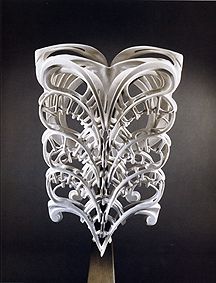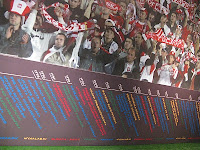I still remember jokes that puzzled me in my youth and I only figured out some 10 or 20 years later. Similarly, sometimes it takes a while to grasp what is going on in an exhibition. So perhaps the
Ann Hamilton exhibition we saw at the Pulitzer Foundation in St. Louis in August will suddenly be revealed to me in due time. I’ve been fascinated by Ann Hamilton and what she says about her work, the depth, thoughtfulness, and philosophical approach she takes, as well as by the respect she has earned from the art world, evidenced by the Pulitzer’s choice of her for their first artist installation exhibition.
However, the only work I’ve seen by her, her installation at the 1999 Venice Biennale, did not elicit a good response from me. I remember being fascinated and delighted by pink powder floating down the walls and piling up at the edges of the floor of the American Pavilion. But when I - and my two companions - read the label, which explained that the point of the installation was to demonstrate how difficult it is for people to communicate with each other, all three of us walked out, not just puzzled, but infuriated. I don’t know about them, but I was angry that such a lovely abstract environment was loaded with such complicated non-visual content and that the content was totally inaccessible without the label, although having read the explanation, one still didn’t really “see” the meaning she intended to convey. There was more to it: I think a recording a man reading the Declaration of Independence that had been slowed down to sound like a low growl and Braille inscriptions on the walls.
We went to the Pulitzer with curiosity and with fairly open minds, despite this previous disappointment. The Pulitzer is an eccentric institution, open only two days a week (now expanded to include Thursday evenings). So it was not unusual that the attendant at the desk explained a bit about the show and asked us to sign in. When we signed the register, we heard a discordant possibly musical sound coming from far away.
A second attendant asked us to choose a record from a file of unlabeled records. We each took one and she played them while she explained the weekly newspaper-like concordance-related publications Hamilton is producing for the exhibition. Each week she gathers from English-language newspapers around the world phrases containing a word she has chosen from a statement of purpose (we never found the statement). Our week the word was “Be.” The phrases were listed with the chosen word in a column down the center of the page. For $2 we purchased the concordance from August 6 that used “Reveal, Say, Sing, Singing, Song Speak, Speaking, State, Suggest, Tell, Utter, Voice, and World,” much more interesting than “Be,” but nonsensical nonetheless. On the wall behind the record player and the concordance is a video of an arm waving back and forth.
In the big gallery were metal staircases with projectors on top, some of which revolved. They showed fuzzy, vague images mostly of a pencil point moving on paper, sometimes with accompanying scratchy sounds. You could also heard sounds coming from microphones under the air handling system vents that run along the floor of the building. Shelves occupied one very long wall, that square shelving you often see in museum shops because it holds both books and objects well. Maybe 300 shelves, each with two or more papier maché hands, all in shades of beige and taupe. The attendant suggests that you may touch or try on the hands. I tried moving them around; I couldn’t fit my hand into them. Following the shelves down the wall you come to a small gallery with a piano inside, which you are welcome to play.
Going downstairs, we watched another attendant playing with a gadget that had four little metal balls on a small platform. She was busily rotating the platform so the balls rolled around on it. A microphone caught the sound of the balls rolling and magnified and broadcast it. If the attendant touched the microphone one of the pianos would play a few notes. She encouraged us to play with this gadget, which she was only demonstrating. She explained also that there is a second piano in the downstairs gallery and the two pianos are somehow connected so that sometimes playing one will activate the other. People signing in activate them also, as did touching her microphone.
On the top floor is a large table covered with Mexican jumping beans and microphones to catch the sound when they jump. The attendant here explained that the jumping beans are refrigerated when the gallery is closed, and that there are two sets, so one is kept cool while the other is on view, in order to give them rest and delay hatching. She also explained that we could read the concordance into a microphone in that area that I imagine would broadcast through the museum, but we didn’t try it. She said the jumping beans are the only thing in the installation that visitors may not touch.
I had noticed loudspeakers outside the building that broadcast someone saying something, just one sentence. We were given the opportunity to record something for broadcast, but chose not to. As I said to the attendant, I’m really used to not touching works of art and generally prefer not to be part of an art installation, but rather to look at it from outside. Perhaps my reticence is what the exhibition is trying to counter.
So, thinking about the installation in Venice, I figure this exhibition has something to do with communication, which Director Matthias Waschek confirms in his statement: “....the project deals with the raw material of communication. Familiar forms of interaction are de-contextualized, then stitched back together into a new, poetic entity that resonates with our most basic experience.”
O.k., I can see that the attendants speak to us, the videos are visual and depict writing, there are sounds and some fragments of music, and these elements appear randomly, without meaning. I could appreciate that the installation is subtly interactive, but none of the things I was invited to touch or play actually seemed like fun. The attendants were very friendly and talking with them was the best part of the project for me. Is it about the pervasiveness of mindless activity in our society? The videos of writing don’t show anything written or drawn, the pianos don’t play music, the concordances are random, the paper maché hands don’t fit, jumping beans are a fascinating but pointless thing to watch.
The exhibition involves extensive collaborations with other individuals and organizations in St. Louis and it may be these associated performance programs that fill out and enrich the experience. I can imagine that richness from a distance, but am limited to the physical experience of the exhibition and its booklet for my own appreciation of the project.
Looking at the beautifully produced documentation for the project, and reading the poetry Hamilton provided for the catalogue, I can’t avoid feeling that this is important, profound, evocative, emotionally fulfilling stuff. But I remain untouched, befuddled, and disappointed at the visual and experiential emptiness of the installation. On the other hand, a month later I’m still chewing on it.













































